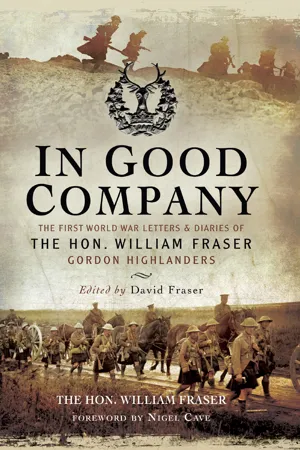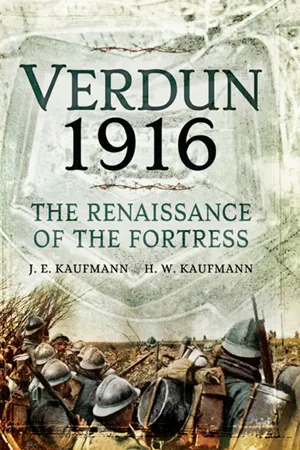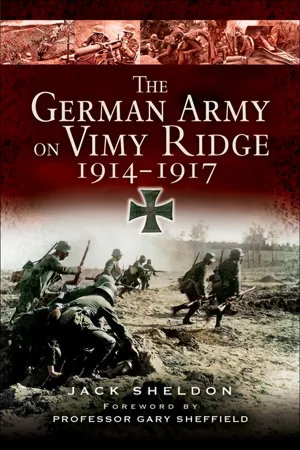Battle of Verdun
The Battle of Verdun, fought during World War I from February to December 1916, was one of the longest and deadliest battles in history. It was a major confrontation between the German and French armies, resulting in massive casualties and extensive destruction. The battle is remembered for its strategic significance and the immense human suffering endured by both sides.
7 Key excerpts on "Battle of Verdun"
- eBook - ePub
Ghosts of War
A History of World War I in Poetry and Prose
- Andrew Ferguson(Author)
- 2016(Publication Date)
- The History Press(Publisher)
...Both armies, amounting together to as many as 1 million men, remained locked in combat throughout the summer, with German attacks being met by French counter-attacks until, in October, a decisive French counter-offensive regained much of the ground lost. The battle lasted, in all, for ten months and was effectively a draw, with 140,000 Germans and 160,000 French killed and another 200,000 Germans and 200,000 French wounded – all together the population of a sizeable town (Strachan, First World War, p.184). René Arcos – The Dead In this poignant French poem, René Arcos summarises the meaningless folly of the Battle of Verdun – all the fighting, all the battles, all the sadness, all the sorrow are, in the final reckoning, worthless because ‘the dead are all on the same side’: The Dead In the wind that blows The veils of widows All float on one side And the mingled tears Of a thousand sorrows In one stream glide Pressing each other close the dead Who own no hatred and no flag, Their hair veneered with clotted blood, The dead are all on the same side. In the one clay where endlessly Beginnings blend with the world that dies The brothered dead lain cheek to cheek Today atone for the same defeat. Divided sons, fight on, fight on, You lacerate humanity And tear the earth apart in vain, The dead are all on the same side; Under the earth no more than one, One field, one single hope, abide, As for the universe can be One combat and one victory. (Translated from French by Christopher Middleton) IN. MEMORIAM: PRIVATE D. SUTHERLAND In May 1916 Mackintosh was selected with another officer to lead a retaliatory raid against the Germans for an attack on the 6th Seaforth Highlanders which had caused severe casualties...
- eBook - ePub
Marshal Joffre
The Triumphs, Failures and Controversies of France's Commander-in-Chief in the Great War
- André Bourachot, Andrew Uffindell(Authors)
- 2014(Publication Date)
- Pen & Sword Military(Publisher)
...Chapter 8 Verdun The Battle of Verdun was not the only reason for Joffre’s dismissal, but certainly contributed to it, as did the failure of the Somme offensive. The Commander-in-Chief was bitterly criticized on three counts: the supposed inadequacy of Verdun’s defences, the disarming of the forts, and the lack of interest shown by himself and GQG in indications that the battle was impending. Some months after the start of the German attack, the first closed session of the parliamentary chambers was held. It was like unleashing a frenzied pack of hunting dogs, for the members of parliament had been obliged to remain silent for almost two years and had built up vast mountains of resentment. Joffre’s departure initially came as a great, collective release – a purging of the frustrations of both individual politicians and parliament as a whole. Highpoint of the war Let’s start by running through the facts of what happened. The Battle of Verdun was fought from 21 February to 15 December 1916, and during this period of almost ten months the French army was worn out in a defensive battle it was often on the verge of losing. The battle cost the French 380,000 men killed, wounded, missing or captured, including almost 9,000 officers. German losses were only slightly lower. For the French, Verdun was the highpoint of the war: although its monthly casualty rates fell far short of those of the Battle of the Frontiers, the sheer duration of Verdun made it unmatched. Why Verdun? There is no obvious answer to this question. Falkenhayn revealed his intentions when he wrote his memoirs after the war: ‘If [the enemy] declined to fight [for Verdun] and let the objective fall into our hands, the moral impact in France would be enormous...
- eBook - ePub
In Good Company
The First World War Letters and Diaries of The Hon. William Fraser–Gordon Highlanders
- William Fraser, David Fraser, David Fraser(Authors)
- 2016(Publication Date)
- Pen & Sword Military(Publisher)
...III France and England 1916–1917 At the end of 1915 the German Chief of the General Staff, Von Falkenhayn, concluded in a written appreciation that while England was the principal support for the Western Entente, Germany’s method of defeating her should be by destroying, through attrition, the French Army. England would then have no effective instrument on land. To force on France a great battle of attrition there must be an offensive against some point which would force the French to commit every Frenchman to its defence. Falkenhayn chose Verdun. On 21 February 1916 the great battle began. Falkenhayn’s object was not breakthrough but destruction of French division after French division, by forcing upon them the necessity of counter-attack and exposure to massive German artillery fire. To achieve this the Germans planned and executed — ultimately at huge cost – a series of limited advances: limited in range but enormous in terms of the mass of men and material employed. The battle made of 1916 a year of crisis for France. The crisis dominated the first six months of the year. One consequence of Verdun was that the brunt of any Allied offensive operations in 1916 had to be borne by the British Army. A joint Franco-British offensive to take place in July had already been agreed in February, before the German attacks at Verdun started. Thereafter the French part in this offensive was inevitably and progessively reduced as Verdun made its own terrible demands. It had been agreed between the Allies (with Haig reluctant over both place and date) that the area for the summer offensive should be in Picardy: the Somme. To his joy Willie’s brigade was moved out of the Ypres sector. 27th Bde 1.1.16 Dear Father, I must say I have been very bad about writing lately, but I have had a most colossal amount to do. However things are settling down a bit more, and the Bde Major is back from leave, so I have more time...
- eBook - ePub
Verdun 1916
The Renaissance of the Fortress
- H. W. Kaufmann, J. E. Kaufmann(Authors)
- 2016(Publication Date)
- Pen & Sword Military(Publisher)
...Chapter Four The Battle of Verdun, 1916 ‘Victory must be ours …’ From a letter by a young German soldier who died only a few weeks after the war began Happy New Year Like two exhausted boxers, the Germans and the French armies rested to recuperate from their wounds and prepare for another round at the end of 1915. This time, both formulated actions for 1916 with every intention of delivering a knockout blow. The optimum time to begin a campaign is in the spring, after the thaw and the rains. Winter weather is the least desirable time for an offensive, especially when it involves trench warfare. General Joffre planned for concentric operations with his allies, which required him to wait until the summer for the Russians to be ready. However, he was prepared to go into action as early as April if the Russians were attacked. Since the Germans had remained on the defensive in the West throughout 1915, Joffre assumed that they would repeat this strategy in 1916. General Falkenhayn, however, had no intention of waiting for the spring since he believed that time was running out for Germany to achieve a decisive victory. Joffre could not afford a repeat of 1915. The morale of the French troops improved, especially when generals like Pétain took steps to improve conditions on the front, gave them leave and provided them with postal services. Ordinary citizens, except those in the occupied lands, had not suffered too much. The Poilu’s equipment and gear had improved. Despite the loss of valuable resources at Briey and Lille, French industry managed to increase production and the USA, which remained neutral, supplemented France’s needs. Above all, the French fought on their soil against an invader and patriotism still ran strong. However, losses like those incurred in 1915 could spell disaster for the war effort...
- eBook - ePub
- Jack Sheldon(Author)
- 2008(Publication Date)
- Pen & Sword Military(Publisher)
...They greeted the wooden props and shuttering timber that carrying parties had brought forward even more warmly than food or drink. They grabbed everything available and called for more wood. Our container was empty. With one last look at the dreadful scenes of the night, we raced hurriedly back across the ploughed up terrain. Artillery fire came down with undiminished violence. We were indifferent to the impact of the shells. You might be hit, I might; the important thing was to get out of this witch’s cauldron as fast as possible. “In our haste we lost the line of the trench, found ourselves in the labyrinth of communication trenches and promptly discovered that we were lost. So began a frantic search, until we met some stretcher bearers who were transporting the wounded to the rear. We attached ourselves to them. Soaked to the skin, our clothes torn and gasping for breath, we arrived back at our dugout in the embankment as dawn broke. My body felt as heavy as lead as I sank down on a straw palliasse. Wild images flitted briefly through my mind until sheer exhaustion calmed my nerves and I was embraced by a deep dreamless sleep.” In comparison with events before Verdun, this attack was a very minor affair. The German army was pleased with the result, but the French dismissed it subsequently in a very few words: ‘On the Tenth Army front there was an assault on Givenchy Wood on 21 [February]. 800 – 900 metres of the French front line was captured, together with 300 – 400 metres of support trenches. Numbers of men from 130th Division were captured … Because they were about to be relieved by British troops no counter-action was taken, but mine warfare continued right up until 12 March between Neuville St Vaast and the Lille road.’ 22 By the third week of March the indicators that the British had taken over from the French on the Vimy sector began to multiply...
- eBook - ePub
The Somme 1916
Touring the French Sector
- David O'Mara(Author)
- 2017(Publication Date)
- Pen & Sword Military(Publisher)
...The breakthrough, which had been ultimately hoped for by Joffre, enabling the use of cavalry beyond the trenches and a return to a war of movement, had proven to be an impossible dream and neither of the principal towns in the area, Bapaume and Péronne (just thirteen and ten kilometres behind the 1 July front lines respectively), had been captured. In the French sector, the key observation and artillery positions of Mont St Quentin and La Maisonnette were still in German hands, as was the Chaulnes railhead and all of the Somme river crossings south of Péronne. The Somme Front, 16 December 1916 (from Der Weltkrieg 1914 bis 1918). By the second week of July, however, the Somme was certainly living up to its primary role - that of a battle of attrition – and it was eventually successful in diverting German reserves and attention away from Verdun, thereby successfully relieving the crisis that had enveloped the French Army there. Another positive factor resulting from this battle was that it was realised that inter-army cooperation could win battles, especially when overall command was given to one person. The French who, up to the launch of the Battle of the Somme, had been more than a little suspicious about the British commitment to the war, also realised that in fact the British were a serious ally who could be trusted to operate alongside them in joint operations. Though not a victory as such, the battle was certainly a strategic success for the Allies. In the course of the offensive, the French Army on the Somme captured somewhere in the region of 41,605 German prisoners (including over 800 officers), seventy one field guns, 101 heavy guns, 104 mortars and 535 machine guns. Sources – almost needless to say – disagree about casualties; an authorative source states that the French suffered 202,567 casualties throughout the battle of whom 66,688 were recorded as killed or missing...
- Colonel John Buchan(Author)
- 2014(Publication Date)
- Verdun Press(Publisher)
...During the morning there seemed to be a concentration for a counter-attack near Bostin Farm, but this was dispersed by our guns. Only small parties moving from shellhole to shell-hole advanced, and these never came nearer than 800 yards. By the evening of that day on nearly all the British front of attack the final objectives had been reached. The 9th Division had carried theirs in the record time of three hours. That day’s battle cracked the kernel of the German defence in the Salient. It showed only a limited advance, and the total of 3,000 prisoners had been often exceeded in a day’s fighting; but every inch of the ground won was vital. Few struggles in the campaign were more desperate or carried out in a more gruesome battlefield. The mass of quagmires, splintered woods, ruined husks of “pill-boxes,” water-filled shell-holes, and foul creeks which made up the land on both sides of the Menin road was a sight which, to the recollection of most men, must seem like a fevered nightmare. It was the classic soil on which, during the First Battle of Ypres, the 1st and 2nd Divisions had stayed the German rush for the Channel. Then it had been a battered but still recognizable and featured country-side; now the elements seemed to have blended with each other to make of it a limbo outside mortal experience and almost beyond human imagining. Only on some of the tortured hills of Verdun could a parallel be found. The battle of 10th September showed to what heights of endurance the British soldier can attain. It was an example, too, of how thought and patience may achieve success in spite of every disadvantage of weather, terrain, and enemy strength. Delville Wood was still for the Brigade the most heroic episode in the War. But its advance on 10th September must without doubt be reckoned its most successful achievement up to that date in the campaign...






![The History Of The South African Forces In France [Illustrated Edition]](https://img.perlego.com/books/RM_Books/inde_pub_group_sqonxaw/9781782893769_300_450.webp)